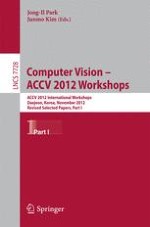The two volume set, consisting of LNCS 7728 and 7729, contains the carefully reviewed and selected papers presented at the nine workshops that were held in conjunction with the 11th Asian Conference on Computer Vision, ACCV 2012, in Daejeon, South Korea, in November 2012. From a total of 310 papers submitted, 78 were selected for presentation. LNCS 7728 contains the papers selected for the International Workshop on Computer Vision with Local Binary Pattern Variants, the Workshop on Computational Photography and Low-Level Vision, the Workshop on Developer-Centered Computer Vision, and the Workshop on Background Models Challenge. LNCS 7729 contains the papers selected for the Workshop on e-Heritage, the Workshop on Color Depth Fusion in Computer Vision, the Workshop on Face Analysis, the Workshop on Detection and Tracking in Challenging Environments, and the International Workshop on Intelligent Mobile Vision.
